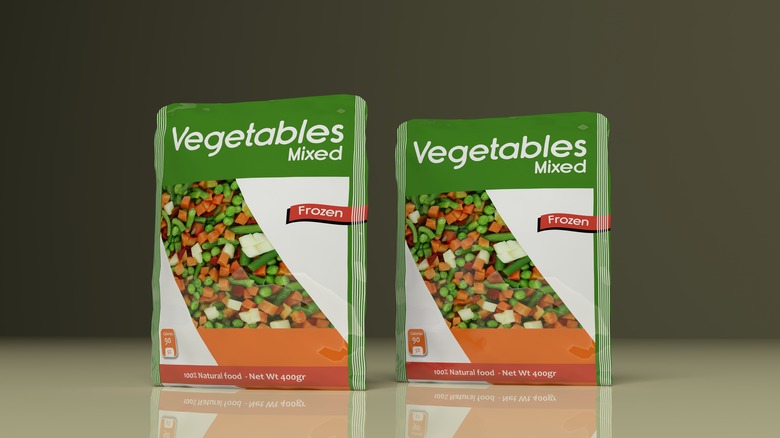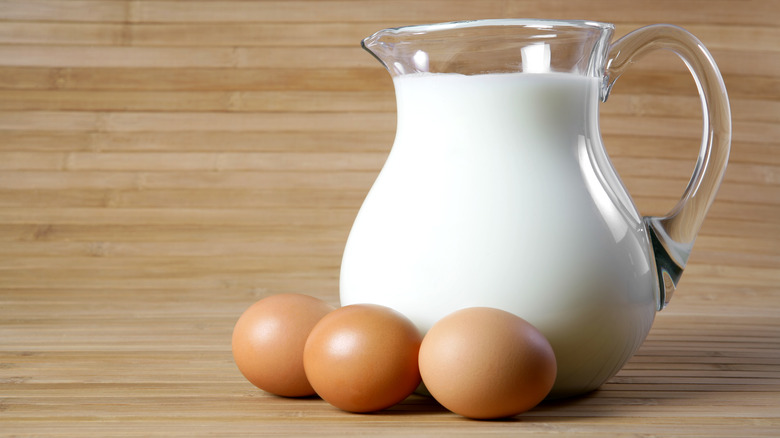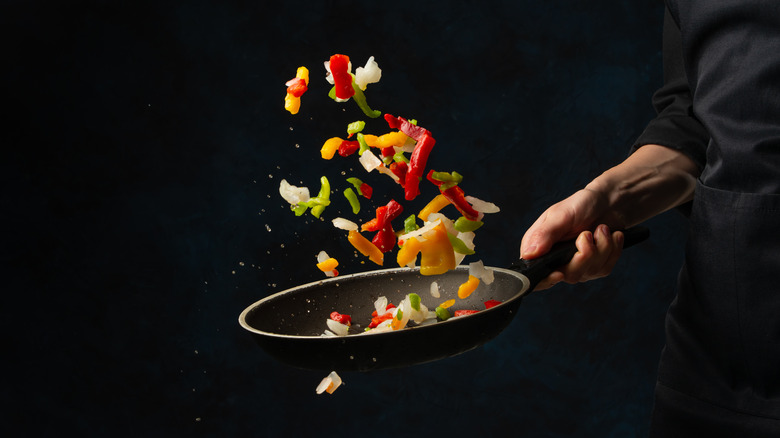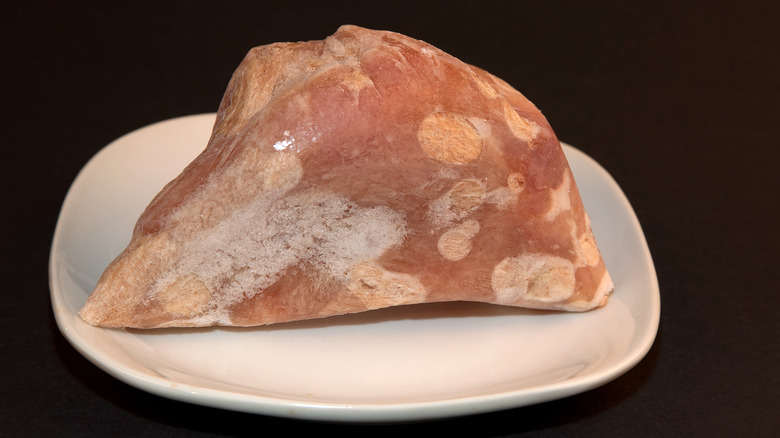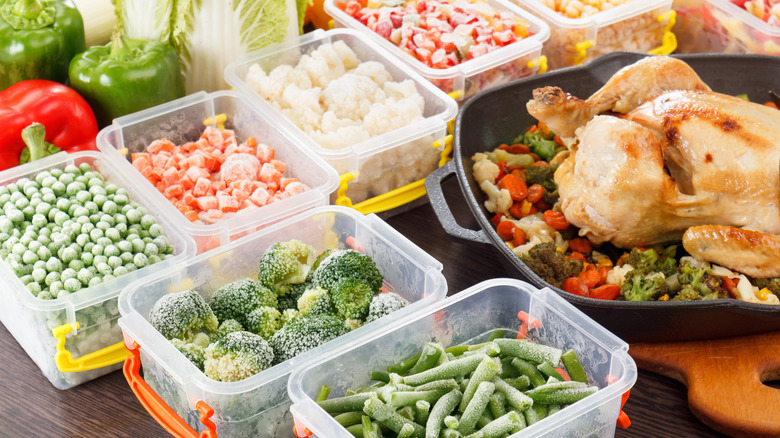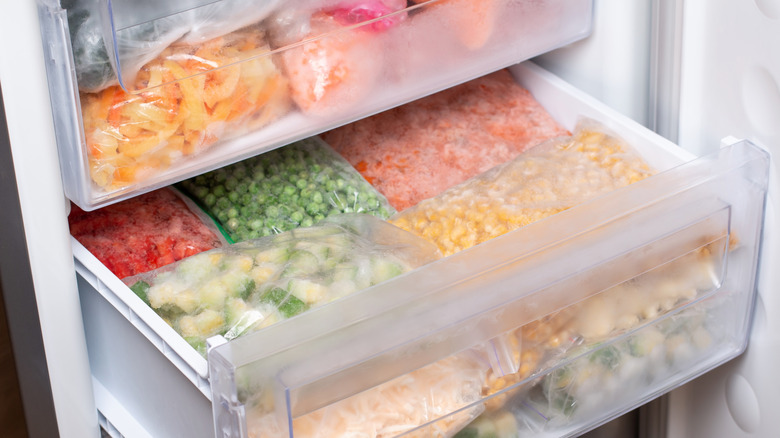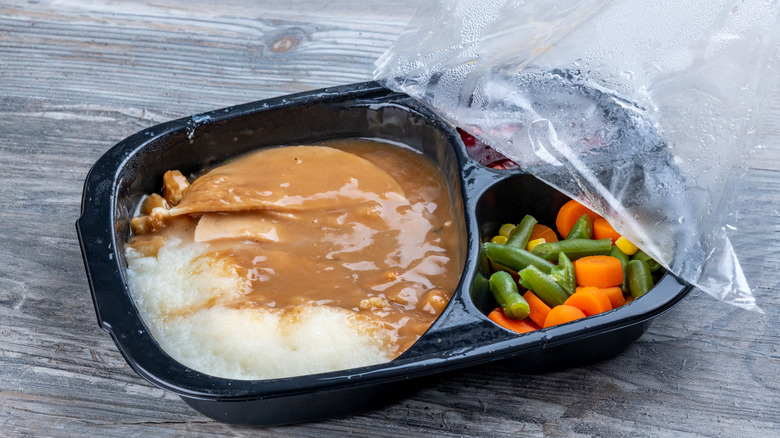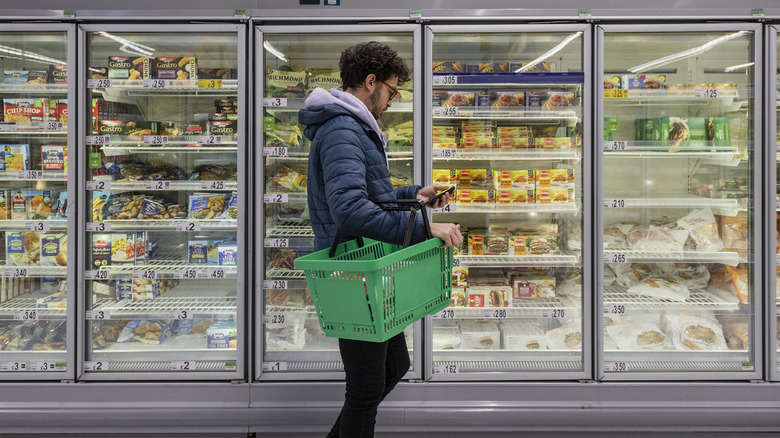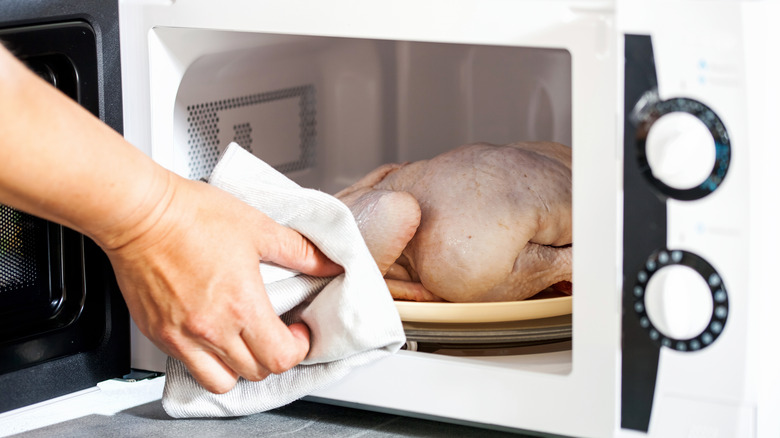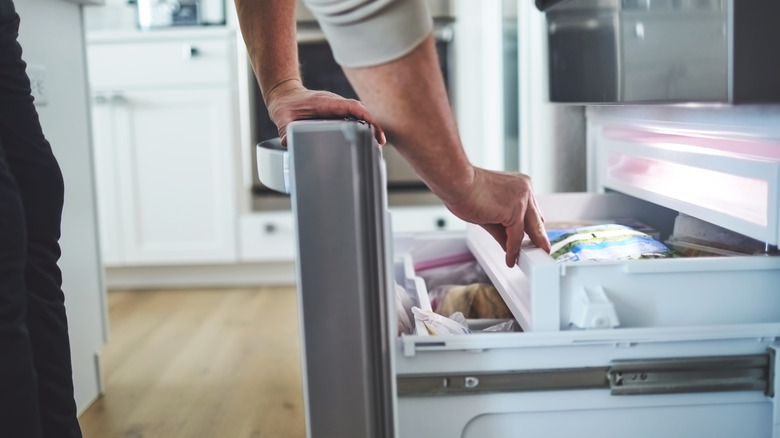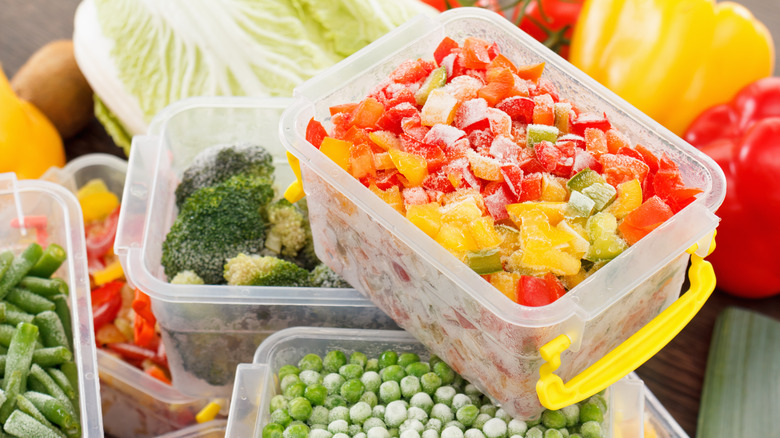False Facts About Frozen Food You Thought Were True
Americans have had a longstanding love affair with frozen food, dating back to the mid 20th century when the convenience of frozen meals revolutionized the way people ate. And the U.S. frozen food market isn't showing any signs of slowing down. According to Grand View Research, the country's frozen food market was valued at $55.8 billion in 2021 and is projected to grow annually by 4.7% until 2030.
Freezing is an excellent choice when it comes to preserving food and minimizing waste, as it prolongs the freshness of a wide range of ingredients and meals. It can also help ensure that you have access to your favorite goodies even when they're out of season. Beyond this, freezing can also help retain many nutrients in food and allows for bulk buying and fewer trips to the grocery store.
Unfortunately, frozen food has been the subject of numerous myths, most of them negative. Many people associate frozen meals with subpar flavors, inferior nutrition, and artificial additives. Luckily, we're here to dispel these misconceptions and help you make the most of frozen food.
False: Food is best frozen in its original packaging
If you think that frozen food comes optimally packaged for longevity, you may want to think again. Frozen food packaging is designed for transportation and storage at the supermarket, but not necessarily for long-term freezing in your home. That original packaging usually doesn't provide an airtight or moisture-resistant seal, which is crucial for preserving the texture and flavor of frozen foods, as well as protecting them from picking up odors. Additionally, store packaging can deteriorate over time, leading to the dreaded freezer burn, which can negatively affect the quality and taste of the food (more about this later).
Unless you're planning to eat the frozen food within a couple of weeks, it's a good idea to repackage it before popping it in the freezer. For best results, transfer the frozen food items to freezer bags, pushing out as much air as possible before you seal them. Some of the most popular storage options include freezer-safe zip-lock bags, reusable silicone bags, and freezer paper. When freezing liquid items such as soups, stews, or sauces, it's especially smart to use airtight containers. Freezer containers are usually made from plastic, feature airtight lids, and are sometimes even stackable to ensure the best use of your valuable freezer space.
False: All food freezes well
While you can freeze most types of food, there are some items that simply don't fare well in sub-zero environments and can undergo undesirable changes in texture or flavor when exposed to extremely cold temperatures.
Veggies such as lettuce, celery, and parsley are likely to end up limp and water-logged when defrosted after ice crystals puncture their cell walls. Cooked rice or spaghetti also tends to lose its texture and can become mushy in the freezer. Meanwhile, cooked egg whites are prone to taking on a rubbery, spongy consistency when frozen. It's also unwise to freeze eggs in their shells, as they may crack, leaving them susceptible to bacteria. Dairy products such as milk, mayonnaise, yogurt, and sour cream may curdle or separate upon thawing. Additionally, fried foods could lose their crispness after thawing, since oil does not typically freeze.
Freezing also changes the flavor of many spices and seasonings. Additions such as garlic, pepper, cloves, and certain herbs have a tendency to go bitter when frozen. Freezing salt, on the other hand, can result in the loss of flavor. Freezing can also add a rancid undertone to any food that contains fat. And despite what you may have heard, freezing coffee is generally not recommended because it exposes the beans to moisture, which can negatively impact their taste and overall quality.
False: It's safe to freeze hot foods
No matter how tempting it may be, trying to freeze hot — or even warm — food can jeopardize the safety of both the food itself and neighboring items in the freezer. According to the USDA, the so-called danger zone for food, which can promote the growth of bacteria, lies between 40 to 140 degrees Fahrenheit. To keep it bacteria-free, food should never be left in the danger zone for longer than two hours. Since hot food naturally takes longer to freeze, you run the risk that it will spend too much time in the danger zone, allowing harmful bacteria to multiply. In addition, placing hot food directly into the freezer can raise the temperature inside the whole compartment, potentially affecting the safety of other stored items that may start to defrost.
To prevent any safety hazards, you must cool food down thoroughly before placing it into the freezer. Michigan State University recommends a two-stage cooling process. First, separate food into smaller portions that you will turn place in containers or freezer-safe bags. Next, either place the packaging in the refrigerator to bring down its temperature or pop it in a large pot (or kitchen sink) filled with cold water and ice. While stirring the water in the pot or sink can accelerate the cooling process, be careful not to let any of the water come into direct contact with the food.
False: Eating food with freezer burn is dangerous
Freezer burn refers to the deterioration that can happen when food is exposed to oxygen in a freezer for an extended period of time. It typically happens when food is not properly sealed or wrapped. The main effects of freezer burn are changes in the food's texture, color, and flavor. Freezer burn manifests as dry gray or white spots on the food's surface. It can also take the form of ice crystals. This occurs when the moisture within the food evaporates and the residual air inside the packaging takes its place, leaving the items dehydrated. As a rule of thumb, foods with high water content, such as meat and fish, are more susceptible to freezer burn while their low water content counterparts, such as nuts and seeds, generally fare better in the freezer.
While it's unsightly and unappetizing, freezer burn isn't going to make you sick. In fact, sometimes the odd spot of freezer burn is inevitable, as removing every trace of air from packaging by hand can be a tall order. If the freezer burn is localized, simply remove the affected area and proceed as normal. In cases of severe freezer burn, however, you may have to discard the entire item. If you want to minimize the chances of freezer burn, it may be worth investing in a vacuum sealer that more thoroughly removes oxygen from inside packaging.
False: Freezing food kills microbes
While storing food in the freezer at 0 degrees Fahrenheit generally keeps it safe from picking up new pathogens, it doesn't kill anything that's already in the food, such as bacteria, mold, or yeast. What it does is render them inactive. More specifically, the low temperature keeps microbes in a dormant state. This is precisely how freezing preserves food — by stopping the growth of microorganisms that are responsible for spoiling food and causing gastrointestinal problems.
But when the temperature of frozen food rises above 40 degrees Fahrenheit, all the microorganisms that were there when you froze it become active again. Under favorable conditions, the pathogens will multiply to a number that may lead to food poisoning. This could happen if the food is thawed and left unattended for longer than two hours. Additionally, fluctuations in freezer temperature can also contribute to microbial growth. This can occur during power outages or if the freezer door is left open for extended periods of time.
False: Freezing food destroys all nutrients
While it may seem counterintuitive, the fact is that frozen food can sometimes be more nutritious than its fresh counterparts. This is because vegetables and fruit meant for freezing are typically harvested at peak ripeness. They're also flash-frozen, or frozen very quickly, in a process that helps to lock in vitamins and minerals. These nutrients would gradually degrade and be lost if the produce was purchased fresh and kept on the kitchen countertop or in the refrigerator for too long.
A 2017 study published in the Journal of Food Composition and Analysis found no significant difference in the levels of nutrients in fresh and frozen food, such as green beans, blueberries, and cauliflower. In fact, according to the study, frozen produce was more nutrient-rich than produce kept in the refrigerator for five days.
Vegetables intended for freezing are usually blanched at temperatures of around 90 degrees Fahrenheit. This eliminates enzymes that could otherwise lead to discoloration and flavor loss. Gene Lester, a plant physiologist at the USDA, explained that "From a commercial standpoint, you definitely have a more nutrient-dense product than something that has likely been picked, refrigerated, then put on a truck for up to three days, then stored in a warehouse [...] before arriving at a grocery store for a few days" (via CBS News).
False: All frozen food is unhealthy
Many of us consider frozen fruit and veggies to be less healthy than their fresh counterparts, in part because we assume that they must be packed with artificial additives and excessive sugar or salt to prolong their shelf lives. While this can sometimes be accurate for certain frozen foods, it's by no means the norm.
The best way to ensure that you're getting the healthiest possible frozen goods is to look at the label before purchase. As a rule of thumb, the longer the ingredient list, the more likely the product is to contain nasties. Opt for meals with at least 10 grams of protein and fewer than 600 grams of sodium, and avoid those with high saturated fat and added sugar. If you're in doubt, reach for "light" or "lean" meals, as they usually come with fewer calories and less fat and sodium. In addition, always look at the serving size on the label, as manufacturers can get sneaky and make recommended portions overly small to make their product appear healthier.
False: All frozen meals contain preservatives
As we become more aware of our eating habits, the frozen food industry has been subject to a substantial transformation that includes offering healthier and more wholesome choices. And while some frozen products remain focused on convenience, other manufacturers are doing their best to cater to the growing demand for healthy meal options. Luckily, this means that when it comes to frozen food, preservatives and high sodium levels are becoming less common.
Frozen products don't necessarily require a lot of preservatives to increase their shelf life, since freezing is a form of food preservation that has been used for many, many centuries. Chinese people were already using blocks of ice to store food in 1,000 B.C.. More then two millennia later, the world's first commercial freezing facility opened in 1861 Australia. While the operation wasn't a great success at the time, it paved the way for frozen food technology.
In the modern era, ehile some frozen meals may indeed contain high levels of preservatives such as sodium, this is by no means a given. Many frozen meals contain fewer than 600 milligrams of sodium, which is more than acceptable, especially when compared to some fast food options.
False: Frozen food can expire
While frozen food will lose its flavor and texture over time, it's not really going to expire, as explained by FoodSafety.gov. This holds true so long as that food is consistently kept below 0 degrees Fahrenheit. In other words, if your food has been sitting in the refrigerator for years, enduring numerous power outages, it's best to bid it farewell.
However, food degrades in quality the longer it's frozen. If you're uncertain whether a thawed item is safe to eat, consult your nose. While defrosted food that looks unappealing may still be safe to eat (after all, freezer burn is pretty common), items that smell rancid are a definite no-no. If in doubt, always err on the side of caution.
As per FoodSafety.gov, fresh beef, lamb, veal, and pork are best consumed between four and 12 months of freezing. Meanwhile, uncut fresh poultry should remain at its peak in the freezer for up to a year. This goes down to between two and six months for cooked meat. Soups and stews are best utilized within three months of the freezing date, while fish remains at its peak quality within a window of two and eight months from freezing, depending on the type. Finally, bacon and sausages are best enjoyed within only one to two months of freezing.
False: It's safe to thaw food on the kitchen counter
Thawing food on the kitchen counter (or even in other places throughout the home, like the porch) is an all too common practice. However, it's generally not recommended due to concerns about food safety. This is because bacteria can multiply rapidly at room temperature, potentially leaving you with a nasty case of food poisoning. However, it's important to remember that some frozen items don't require defrosting. For instance, soups, stews, and sauces can be easily reheated straight from their frozen forms. Frozen berries can also be popped right into a blender to make smoothies.
There are three methods for safely thawing food. The safest — albeit somewhat time-consuming — approach involves placing frozen food in the refrigerator. This method prevents the items from entering the temperature danger zone, where they could start to develop bacteria. If you decide to use this method, it's essential to plan ahead. That's because small items may take overnight to defrost, while larger items may require several days. A faster method of thawing food involves placing it in leak-proof bags before submerging it in bowls of cold water. For best results, change the water every half hour. If time is of the essence, pop your frozen goodies in the microwave and set it on the defrost setting, though this may affect the texture of your meal.
False: It's never safe to refreeze food
Frozen food is a lifesaver when it comes to convenience and reducing food waste. However, when you're thawing something out and your dinner plans change, you might wonder if it's safe to refreeze partially defrosted ingredients, especially fish or meat. The good news is that you can refreeze most foods, provided that you follow a few important guidelines.
If you've thawed food in the refrigerator and kept it under 40 degrees Fahrenheit for no longer than four days, you can generally return it to the freezer without compromising its safety. That said, it's likely that the food may lose some texture and flavor thanks to moisture loss during thawing. It's also safe to freeze cooked dishes made from defrosted raw food. However, it's crucial that you don't refreeze any items that have been left at room temperature for more than two hours. This also goes for foods that have been sitting in temperatures above 90 degrees Fahrenheit for longer than an hour.
On the other hand, there are a few items that should never be refrozen. For instance, ice cream and some other frozen desserts don't refreeze well, as they tend to develop an unappealing icy texture when refrozen. Instead, consider using any leftover ice cream in milkshakes or smoothies where the melted texture won't matter so much.
False: Frozen food is more expensive than fresh food
While it's definitely not a given for all food, a lot of frozen items are cheaper than their fresh counterparts. In fact, the cost savings associated with frozen food compared to fresh can reach 50% or even more in some cases. After comparing prices of frozen and fresh foods at a variety of grocery stores in the U.K., Which? found that frozen items were generally more budget-friendly.
The value of frozen food goes beyond price, however. The fact that frozen food can be stored for months or even years minimizes waste as well as the financial burden of discarding anything that went bad before you could eat it. Buying frozen goods is also a great way to stock up on food that becomes expensive out of season, such as berries or winter squash, or food that's simply cheaper bought in bulk. By capitalizing on discounts, you can stock up on frozen fruits, vegetables, and meats, ensuring that you always have them on hand for a good price.

